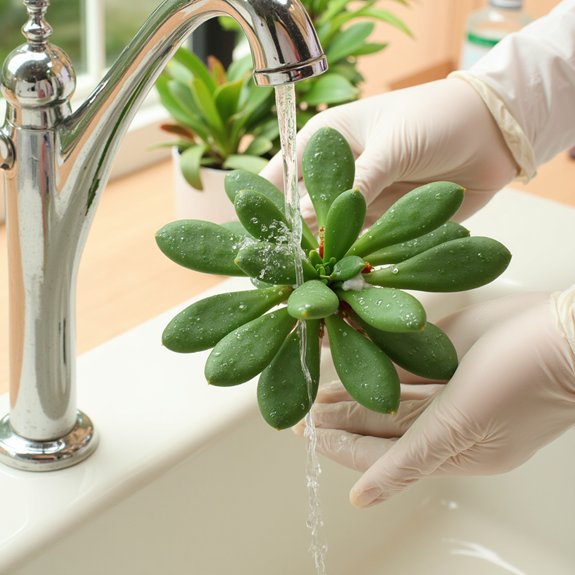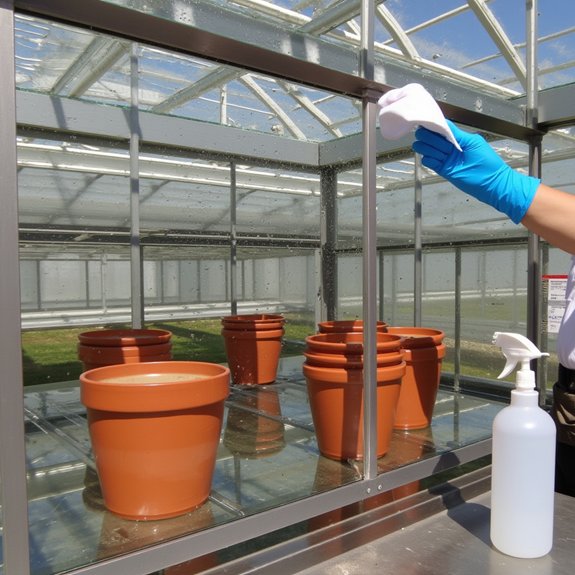You’re admiring your succulent collection when you spot something troubling—tiny white, cottony clusters nestled between leaves and stems. These aren’t harmless fuzz balls; they’re mealybugs, one of the most persistent pests that can devastate your plants within weeks if left unchecked. Acting fast makes the difference between saving your succulents and watching them slowly weaken and die, but knowing exactly what steps to take next determines your success rate.
Contents
- 1 Spotting the Enemy: Early Signs of Mealybug Invasion
- 2 Immediate Action: Isolating Your Infected Succulents
- 3 The Water Treatment: Washing Away the Pests
- 4 Chemical Warfare: Using Rubbing Alcohol for Targeted Strikes
- 5 Deep Clean Protocol: Sanitizing Your Growing Environment
- 6 Fresh Start Strategy: When to Repot Your Succulents
- 7 Victory Maintenance: Long-term Monitoring and Prevention
Spotting the Enemy: Early Signs of Mealybug Invasion

Something’s wrong when you notice white, fluffy spots that look like tiny cotton balls scattered across your succulent’s leaves. These telltale signs mark the beginning of a mealybug invasion that demands immediate attention.
Effective mealybug identification goes beyond spotting the obvious white clusters. You’ll see tiny, moving insects when you look closer, plus webbing around your plant’s center. Ants crawling nearby? That’s another red flag.
Understanding the pest life cycle helps you act fast. Mealybugs hide in cracks, furniture, and soil while multiplying rapidly. Early detection prevents widespread damage and leaf drop.
Immediate Action: Isolating Your Infected Succulents
Once you’ve confirmed a mealybug infestation, your first move determines whether you’ll contain the problem or watch it spread throughout your entire collection. Immediately remove infected succulents from your main growing area. Place them at least six feet away from healthy plants, preferably in a separate room or isolated corner.
These isolation techniques prevent airborne transfer of crawling mealybugs. Don’t rush this step—mealybugs move faster than you’d expect. Check nearby plants for early signs before relocating them too. Effective pest prevention starts with quick quarantine action that stops one infected plant from becoming a collection-wide disaster.
The Water Treatment: Washing Away the Pests

After you’ve isolated your infected succulents, it’s time to physically remove as many mealybugs as possible with water. Use gentle water pressure to avoid damaging delicate succulent leaves. A light spray from your hose or sink works perfectly.
Focus your washing technique on affected areas, targeting white cotton-like clusters where mealybugs hide. Direct the stream carefully around stems, leaf joints, and crevices. Don’t blast the soil, as succulents hate waterlogged roots.
This initial rinse dislodges visible pests and prepares your plant for follow-up treatments. You’ll immediately see fewer bugs clinging to surfaces.
Chemical Warfare: Using Rubbing Alcohol for Targeted Strikes
While water removes visible mealybugs, stubborn pests will cling to your succulent’s hidden spots. That’s where rubbing alcohol becomes your secret weapon. Use 70% isopropyl alcohol for maximum effectiveness without harming your plant.
For targeted application, grab a spray bottle or cotton swabs. Spray directly onto white, fuzzy clusters, ensuring complete coverage of stems and leaf joints where bugs hide. Cotton swabs work perfectly for precision strikes in tight spaces.
The alcohol kills mealybugs instantly on contact, dissolving their waxy protective coating. You’ll likely need repeat treatments every few days until the infestation’s completely eliminated.
Deep Clean Protocol: Sanitizing Your Growing Environment

Since mealybugs scatter beyond your plant when disturbed, you’ll need to sanitize the entire growing environment. Mix a solution of 70% isopropyl alcohol with water in a 1:1 ratio for effective cleaning.
Wipe down all surfaces within a three-foot radius of infected plants, including shelves, windowsills, and nearby furniture. Don’t forget pot saucers and decorative stones where bugs love hiding.
Clean your cleaning tools between each surface to avoid spreading pests. Replace sponges and cloths after use, or soak them in alcohol solution for 10 minutes before reusing on uninfected areas.
Fresh Start Strategy: When to Repot Your Succulents
When mealybugs have established themselves in your succulent’s soil, repotting becomes your nuclear option for complete pest elimination. You’ll need to completely remove all existing soil, wash roots thoroughly under running water, and scrub away any visible bugs or egg clusters.
Choose fresh, well-draining soil specifically formulated for succulents. Proper repotting techniques include cleaning your pot with 70% isopropyl alcohol, allowing roots to dry for 24-48 hours before replanting, and monitoring closely for two weeks afterward.
Smart soil selection means avoiding moisture-retentive mixes that create humid conditions mealybugs love.
Victory Maintenance: Long-term Monitoring and Prevention
After you’ve successfully eliminated mealybugs from your succulents, establishing a consistent monitoring routine becomes your best defense against future infestations. Schedule regular inspections every two weeks, examining leaves, stems, and soil surfaces for early warning signs. Check hidden areas where mealybugs typically gather first.
Implement preventive measures by maintaining proper air circulation around plants and avoiding overwatering. Clean your tools between plant handling sessions. Keep new plants quarantined for three weeks before introducing them to your collection.
Document inspection dates and findings in a simple log, noting any suspicious white spots or cotton-like residue for immediate action.
